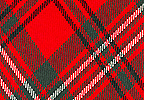Clan/Family Histories
- Scott

1.jpg)
One of the most powerful of the Border families, the name was derived from the Scots who invaded Dalriada (Argyll) from Ireland (the Latin word Scotti was originally used to describe the Celts of Ireland). The surname is now found in all parts of Scotland. The name would often have been applied to people who spoke Gaelic in the English speaking Lowlands, rather than someone who originated in the west of Scotland. The first record of the name Scott is when Uchtred filius Scot witnessed the foundation charter of Selkirk in 1120. "Uchtred" is in fact a good English name of the time and he probably came from south of the border. Henricus le Scotte witnessed a charter by David Earl of Strathearn around 1195.
Michael Scott "the wizard" originated in the Tweed Valley but lived in Fife where he gained his reputation for magic. In the last quarter of the 13th century the Scotts appear in Fife when Michael Lescot agreed to serve King Edward I of England overseas. (In the 16th century author Sir John Scott would build Scotstarvit Tower near Cupar in Fife which is now a prominent landmark).
In the Ragman Roll (all nobles and landed gentry were required to sign by Edward I in 1296) there are six Scott lairds. One of these, Sir Richard le Scot of Murthoxton (now Murdostoun) in Lanarkshire may have acquired those lands by marriage - he also had estates in Selkirkshire. It is his line which became established and spread out between Ettrickdale and Liddesdale. Sir Michael Scott, 2nd Laird of Buccleuch was a staunch supporter of Robert the Bruce. The Lanarkshire estate was exchanged for Branxholm in Selkirkshire as the family became more and more established in the Borders. In the 15th century, as was common in the Borders, the Scotts quarrelled frequently with their neighbours, particularly the Kerrs. The feud caused the deaths of both chiefs and was only resolved by marriage during the chieftainship of the 10th Laird. The 13th Baron was created Lord Scott of Buccleuch by James VI and in 1619 Lord Scott was created an Earl. The male line failed and Anne, Countess of Buccleuch married the illegitimate son of King Charles II, the Duke of Monmouth. Charles created the couple Duke and Duchess of Buccleuch but the Duke supported the Protestant cause and at one stage led an unsuccessful rebellion against King Charles. The third Duke of Buccleuch married the heiress of the Duke of Queensberry (the Douglas family) and became one of the richest men in Britain. In the 19th century, Sir Walter Scott (from a junior branch, the Scotts of Harden) changed Scotland's image forever. The Duke of Buccleuch today is one of the largest landowners in Scotland and the art collections at the family's great houses of Drumlanrig, Bowhill and Boughton are internationally famous.
The clan motto is "Amo" (I love).
The Laidlaw family is regarded as a sept (sub-branch) of the Scott family.
Scott was the 10th most frequent surname at the General Register Office tables of Top 100 Surnames in Scotland.
There are Scott family Web sites here and here as well as here.
There was a BBC TV series on the Clans and Families of Scotland including one on Anna Scott who was no more than a girl when she became the Duchess of Buccleuch in the mid-17th century. Her marriage to the son of Charles II propelled the Scotts into the first rank of British nobility but it very nearly ended in disaster. This is the story of the Scotts' journey from reivers to royalty:
Return to Index of Clans/Family Histories.
Where else would you like to go in Scotland?

